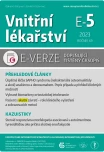The patient with acute vertigo – the role of clinical examination and imaging
Authors:
Lukáš Martinkovič
Authors‘ workplace:
Neurologická klinika 2. LF UK a FN Motol
Published in:
Vnitř Lék 2023; 69(E-5): 20-24
Category:
doi:
https://doi.org/10.36290/vnl.2023.067
Overview
Vertigo/dizziness or balance disorders are among the most common patients complaints in emergency clinics. Up to 25% of them are potentially life-threatening, especially cardiovascular or cerebrovascular events. The combination of a careful history taking (triggers, duration of difficulties, associated symptoms) and the performance of a basic vestibular examination (nystagmus, oculomotor, head impulse test, positional maneuvers, standing and walking examination) leads to a reliable differentiation of central and peripheral vestibular etiology. Standardized diagnostic algorithms (HINTS, HINTS+, STANDING) are used to identify high-risk patients requiring urgent care. Imaging methods must be interpreted with caution to their low sensitivity in acute phase (sensitivity of non-contrast brain CT for ischemia in the posterior cranial fossa is only 16%, MRI of the brain is false negative in up to 20% of cases in stroke patients in the first 48 hours).
Keywords:
stroke – Neuroimaging – Vertigo – vestibular system – head impulse test – nystagmus
Sources
- Newman-Toker DE, Hsieh YH, Camargo CA Jr, et al. Spectrum of dizziness visits to US emergency departments: cross-sectional analysis from a nation-ally representative sample. Mayo Clin Proc. 2008;83:765-775.
- Royl G, Ploner CJ, Leithner C. Dizziness in the emergency room: diagnoses and misdiagnoses. Eur Neurol. 2011;66:256-263.
- Tehrani, A. S. S. et al. Rising Annual Costs of Dizziness Presentations to U.S. Emergency Departments. Acad Emerg Med. 20,689-696(2013).
- Zwergal A, Dieterich M. Vertigo and dizziness in the emergency room. Curr Opin Neurol. 2020(33):117-125.
- Koucký V, Balatková Z, Čada Z, et al. Akutní závrať – příručka pro praxi, Maxdorf, Praha, 2022.
- Newman-Toker, et al. TiTrATE: A Novel, Evidence-Based Approach to Diagnosing Acute Dizziness and Vertigo, Neurol Clin. 2015.
- Kattah JC, Talkad AV, Wang DZ, et al. HINTS to diagnose stroke in the acute vestibular syndrome: three-step bedside oculomotor exa-mination more sensitive than early MRI diffusion-weighted imaging. Stroke 2009;40:3504-3510.
- Jeřábek J. Algoritmy diagnostiky a léčby závrativých stavů. Neurol. praxi. 2020;21(6):472-476.
- Hwang P, et al. Comparative Sensitivity of Computed Tomography vs. Magnetic Resonance Imaging for Detecting Acute Posterior Fossa Infarct. J Emerg Medicine. 2012.
- Chalela JA, et al. Magnetic resonance imaging and computed tomography in emergency assessment of patients with suspected acute stroke, Lancet 2007.
- Kerber KA, Brown DL, Lisabeth LD, et al. Stroke among patients with dizziness, vertigo, and imbalance in the emergency department: a population-based study. Stroke. 2006;37:2484-7. 12.
- Kabra R, Robbie H, Connor SE. Diagnostic yield and impact of MRI for acute ischaemic stroke in patients presenting with dizziness and vertigo. Clin Radiol. 2015;70:736-742.
- Jeřábek J. Diagnostika pacienta s akutní závratí. Česká a slovenská neurologie a neurochirurgie. 2015(78): 03-510.
- Ambler Z, Jeřábek J. Diferenciální diagnóza závratí. 2. vyd. Praha: Triton, 2008, ISBN 978-80-7387-127-7.
- Čada Z, Černý R, Čakrt O. Závratě. Medicína hlavy a krku. Havlíčkův Brod: Tobiáš; 2017. ISBN 80-7311-165-6.
Labels
Diabetology Endocrinology Internal medicineArticle was published in
Internal Medicine

2023 Issue E-5
Most read in this issue
- Successful treatment of SAPHO syndrome (chronic nonbacterial osteomyelitis and acne) with anakinra and denosumab. Case report and review of therapy
- The patient with acute vertigo – the role of clinical examination and imaging
- Selected biomarkers of orthostatic intolerance
- Steroid responsive encephalopathy associated with autoimmune thyroiditis as a cause of acuteencephalopathy
